Nfolgai is an arid world and the only habitable planet in the Nfolgai system. Occupied at various points throughout history by the Sith Empire, Nfolgai served as a mausoleum world for the followers of Sorzus Syn. Abandoned by the Sith as their Empire fell into chaos, the slave populations were left to fend for themselves. The world was rediscovered in 35 ABY by the One Sith, and eventually became site of one of the first clashes between their order and the Dark Jedi Brotherhood.
Description
 Woyunoks seen from Nfolgai's orbit.
Woyunoks seen from Nfolgai's orbit. The Nfolgai system is located at the edge of Sith Space, right on the edge of the Stygian Caldera. It is situated along the Descri Wris, a remote hyperlane branch connecting to the Nacha Bhelfia loop via Athiss and Ziost. The remote location of the world lead to it never being heavily populated by the Sith Empire at any point, and it remained mostly hidden and tucked away from the rest of the galaxy for thousands of years after the Empire's demise.
The stellar primary of the system was named Woyunoks, or "little one", in the ancient Sith language given its small size. A K-type main sequence star, Woyunoks was smaller and cooler than most stars with habitable planets within the territory of the old Sith Empire. Nfolgai is the third planet from the star, located at the extreme edge of the star's life zone. The inner two planets, Mysia and Triax, lack any atmosphere and are essentially barren rocks. The outermost planet, Gryin, is a large gas giant with twelve terrestrial moons. The orbit between Nfolgai and Gyrin is dominated by a dense asteroid belt. This belt is thought to be the remains of a proto-planet whose formation was prevented by Gyrin's gravitational field.
Geography
With copious mountain ranges and desolate wastelands, Nfolgai’s northern hemisphere provides little sustenance to support large populations of settlers. The northern mountain ranges stretch for thousands of kilometers, leaving terrain that offers little in the way of habitable valleys or farmable land.
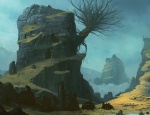 Nfolgai's arid northern region.
Nfolgai's arid northern region. The equatorial mountain ranges are older than those of the north and are consequently far less imposing. This area remains very hilly and arid. The soil, much more metallic than in the north, begins to deepen in color when compared to the sandy dust.
The south is marked with smaller, gentler mountains, and its valleys are made up entirely of jungles and still comparatively arid swampland. The largest of such valleys span for several hundred kilometers. This southern region boasts the only real farmable land over the planet's surface, but the growing season is short due to the harsh climate.
The north and south polar caps contain nearly all of the water on the planet, frozen in large glaciers. The mountains are smaller near the pole and are completely frozen over.
Climate
Between the barren wastes in the north and the dense jungles in the south, the weather in between is unpredictable at best and downright destructive and impassable at worst. The Dark Side influence can be felt in how the weather is corrupted, with random bouts of acid rain, black lightning, and other manifestations of unusual and altered states. The tall mountains of the north provide for a vast difference in air pressures and create winds that can become violent and swirl through their valleys. Frequent storms of stinging rains and deadly sand twisters rage back and forth, caused by the upheaval in the atmosphere.
There is very little water on the planet that isn’t frozen at the poles. Most of the free water is in the southern jungles and marshes, though even there it is somewhat sparse. Due to the lack of water, the flora on Nfolgai adapted to make use of the high metallic-mineral content in the soil in order to maintain their structure in the absence of water. This adaptation has left the plants themselves with very high metal content, making scanners and sensors virtually useless in the southern jungles. The more barren climate of the north offers very little in the way of flora. The plants native to this region bury their roots deep into the crust of the planet, absorbing what little water is available as well as the minerals required to sustain life.
History
Pre-Republic
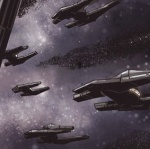 Rakatan ships used by the Sith.
Rakatan ships used by the Sith. Nfolgai was first settled by outsiders following the Rakatan invasion of Korriban and the death of the Sith King, or Sith'ari, Adas around 27,700 BBY. Using the remains of captured Rakatan ships, as well as a newfound knowledge of the Dark Side of the Force, the newly formed Empire conquered and occupied many of the worlds surrounding Korriban. This included Nfolgai and the new capital of Ziost.
Nfolgai was not settled heavily by the Empire at this point, as the stability of the central leadership was short lived. With Adas dead, there was little of the unifying authority that had allowed the Sith to fend off the Rakata. The original Empire collapsed into warring factions, eventually regressing technologically back to a state much like that which had preceded the reign of Adas. This collapse led to Nfolgai being cut off from the rest of Sith society and its small population being forced to fend for themselves.
Sith Rule
The Sith Empire began again on Korriban circa 6,900 BBY with the arrival of the Exiles, fallen Jedi who had fought against the Jedi Order at the end of the Hundred-Year Darkness and been banished from known space. The Dark Jedi arrived on a planet that was torn apart by millennia of civil war. In short order, the Jedi brought the Sith to heel. The armies of the new Empire spread out from Korriban, reconquering the worlds inhabited by the Sith twenty thousand years earlier. During the intervening years, the population of Nfolgai had increased significantly, ruled by a cabal of Kissai priests. The planet's inhabitants were routed quickly by armies of Massassi warriors, who were ruthless in their conquest. The newly conquered world was then settled anew by a wave of Sith and their slaves, including the Mrlssi, Draethos, and Humans.
After the newly anointed Sith Lords had settled on Ziost, they once again made the world the Sith capital. Sorzus Syn then began a survey of the worlds of the Empire. It was on Nfolgai that Syn encountered a Mrlssi slave, propelling her down an avenue of discovery that would track the raids of the Sith in the galaxy at large back through the millennia. Syn would eventually decide to settle on Nfolgai and use the slaves on the world to erect her temple. The Sith would eventually come to revere Syn, who was thought to be the original author of the Sith Code. The Sith came to see Nfolgai as a sacred burial world much like Korriban. Other Sith would be entombed there, often those who most closely followed Syn's path and teachings. Several other temples and tombs would be built on the planet, but none would reach the grandeur of the temple of Sorzus Syn.
 Republic forces attack Nfolgai.
Republic forces attack Nfolgai.The Sith Empire would rule Nfolgai continually until the Great Hyperspace War in 5,000 BBY. With the final setback at the Battle of Primus Goluud, the Sith invasion of Republic space was reversed. In a last act of defiance, Gav Daragon had provided the hyperspace coordinates of the Sith Empire's territories to the Republic. Supreme Chancellor Pultimo ordered an invasion of Sith space, which led to hundreds of ships being dispatched through the Stygian Veil. Situated on the edge of Sith territory, Nfolgai was one of the first worlds to come under attack by Republic forces. Without the Sith’s naval forces able to engage in defense of the world, Nfolgai quickly fell.
After the end of the war and the supposed final destruction of the Sith Empire, the Jedi Order undertook a campaign to try to destroy the legacy of the Sith and prevent any others from falling under the sway of their Dark Side teachings. They destroyed countless numbers of Nfolgai's artifacts, temples, and tombs, and yet the Temple of Sorzus Syn was overlooked. It was buried deep in the planet's forests with the secret of its existence guarded to the death by those Sith that knew of it. The Republic never found out that it was on the planet and, with their work presumably done, the Jedi left Nfolgai.
Crash of the Render
 The Render entering the Nfolgai System.
The Render entering the Nfolgai System.The next time Nfolgai was visited by the galaxy at large was in 3,956 BBY immediately after the Battle of Rakata Prime. As the Republic defeated the forces of another Sith Empire, that of Revan and Malak, Darth Voren fled the field of battle aboard his Interdictor-class cruiser Render as the Star Forge was destroyed. Voren had always been one to look out for himself above all others. This included him having helped the Jedi strike team capture Darth Revan in order to advance his own position within the Sith hierarchy. Instead of fighting the Republic fleet to the bitter end in order to try to achieve victory, Voren set course for the worlds of the Sith Empire so he could rebuild his forces and continue the fight against the Republic.
Voren's skills, however, were not up to the task of navigating the Stygian Caldera that surrounded Sith space. The Render was severely damaged as it made its last hyperspace jump through the Caldera, the gravimetric shear overloading its hyperdrive. The overload spread to several other systems and left the ship nearly disabled. Upon reversion to realspace near Nfolgai, the Render was unable to maintain a stable orbit. The crew was able to guide the ship to a controlled crash in the southern polar region with the help of Voren's power in the Force.
While the ship itself was left largely intact, the inertial compensators were no longer functioning at the time of the crash, and the force of impact killed nearly everyone on board, including Voren himself. The remaining survivors died of exposure when the last of the power generators failed several days later.
Battle of Nfolgai
 The Repubic garrison during the battle.
The Repubic garrison during the battle. In the years following the Jedi Civil War and the rebuilding of the Jedi Order, the Republic sent forces to guard the abandoned Sith worlds that they still had knowledge of. A fleet was sent to Korriban, while smaller garrison forces were dispatched to other worlds that included Nfolgai. These guard forces would remain until the emergence of the resurgent Sith Empire in 3,681 BBY with the start of the Great Galactic War. With the Sith attacking worlds in the Aparo sector, as well as having ambushed the Republic fleet in the Tingel Arm, the Republic assigned forces to meet this new threat. While Korriban still retained a respectable defense force, Nfolgai was stripped almost entirely.
This was, however, just as the Sith Emperor had predicted. Launching a surprise assault, Sith forces reconquered Korriban easily. Just hours later, Sith forces descended upon Nfolgai in the form of thirty-six Fury interceptors. These ships destroyed eight of the twelve Talon fighters based on Nfolgai while they were still on the ground. The remaining four starfighters were on a system patrol and were unable to return to base in time to engage the attacking Sith ships. Much of the Republic garrison's emplacements were left intact, as the main target of the raid had been the starfighters assigned to Nfolgai.
Three days after the fall of Korriban, a Sith attack force made its first attempt to take the planet. The main invasion force consisted of three Gage-class transports supported by a pair of Terminus-class destroyers. The garrison commander, Major Devereux, ordered his gunners not to open fire on the enemy ships until they had entered the atmosphere in order to begin deploying troops and attack ships. The gunners scored several direct hits on the Sith ships, destroying one of the transports and one of the destroyers. Both ships were lost with all hands, leaving the invasion force significantly underpowered. The Sith withdrew from orbit but continued to launch raids on the Republic garrison. The resistance of the Republic forces prompted the Empire to divert several ships, including four Harrower-class dreadnoughts, from the force that attacked Korriban to support a second invasion attempt.
The withdrawal of the Sith forces from the system opened a window for a possible relief attempt to be mounted by the Republic. A task force led by the Valor-class cruiser Fortitude was prepared to reinforce Nfolgai, with other ships assigned to undertake a raid on Korriban to try to divert Sith attention. Ten days after the attack, the Republic's Strategic Information Service received word that the Sith had dispatched a larger force of warships to attack Nfolgai again. Admiral Greik, the acting head of the Republic forces in the area, ordered the Republic relief group to return to port for fear of their loss to the superior enemy force.
Twelve days after their initial attack, the forces of the Sith Empire once again descended on Nfolgai. Their strike overwhelmed the Republic. The attacking force consisted of the remaining ships from the initial invasion plus the newly arrived dreadnoughts, as well as several thousand additional infantry. Following a day and night of intense fighting, the Nfolgai garrison surrendered to the Sith. Those Republic forces that survived, including a large contingent of civilian support workers, were then enslaved by their Sith masters and taken off world. The Sith would maintain an occupying force on Nfolgai throughout the remainder of the war and throughout the Cold War that followed.
Abandonment
 A human village after a Draethos attack.
A human village after a Draethos attack.When the Sith Emperor's Empire eventually collapsed, the Sith forces left Nfolgai for the final time. The planet's sole remaining population were the now freed slaves of the Sith. The newly freed slaves broke up into tribes consisting of single race populations. The former slaves then fell upon one another. The human and Mrlssi populations were at a disadvantage against the Draethos, a race with a proud warrior tradition even after generations of slavery. The ensuing decades of tribal warfare resulted in the Mrlssi being driven from the temperate areas entirely, taking refuge in the colder northern latitudes. The humans’ smaller population was unable to stand against the warlike Draethos, and they were completely wiped out.
Over the ensuing millennia, the population increased markedly. Neither the Draethos or Mrlssi ever gave rise to chiefdoms or states, never progressing beyond simple tribal societies. This was due to the lack of any real central leadership amongst the Mrlssi paired with the slow societal evolution of the long-lived Draethos. Another contributing factor was likely the Dark Side energy that permeated the planet, warping the inhabitants and increasing the amount of tribal conflict and strife.
Rediscovery
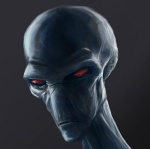 Yobd Nan, leader of the One Sith expedition.
Yobd Nan, leader of the One Sith expedition.Nfolgai would remain unknown to the outside galaxy for the next thirty-five hundred years until its rediscovery in late 35 ABY by a One Sith expedition lead by Yobd Nan. The Sith Lord had been sent by the One Sith to explore the various lost worlds of Sith Space, and he was drawn to Nfolgai due to its strong Dark Side presence. Upon arrival, the One Sith were set upon by the local tribes of Draethos. The ferocity of these attacks, as well as the twisted creatures’ unnatural connection to the Dark Side, fascinated the Sith. As a result, they sent several exploration teams to various points around the planet. Teams that moved into the northern polar regions began to encounter the tribes of Mrlssi, finding them to exhibit the same Dark Side corruption as the Draethos. As they continued to investigate, the One Sith wiped out significant portions of the native tribes. Following weeks of exploration made difficult by the planet's indigenous plant life, the One Sith eventually located the long forgotten Temple of Sorzus Syn in 36 ABY.
As Yobd Nan began to organize a team to attempt to unlock the temple's secrets, forces of the Dark Jedi Brotherhood arrived in system. Several weeks earlier, unbeknownst to Nan, the One Sith had begun a campaign of sabotage and assassination against the Brotherhood. The Brotherhood was now striking back, attempting to gain a foothold inside the Stygian Caldera from which to launch an all-out assault against the One Sith. As armed forces of Clan Naga Sadow and the Houses Scholae Palatinae and Tarentum arrayed themselves to engage in planetary landings, another force of ships arrived in system. Initially thought to be a detachment of the Navy of the Iron Throne sent by the Dark Council, it was soon revealed to be the Ascendant Fleet of House Plagueis. Plagueis, thought to be destroyed following the Horizons Crisis, had instead rebuilt their forces in secret in order to reveal themselves at their chosen time and place. The Brotherhood, assuming from their scans that Nan's forces were in fact a settlement of spacers or pirates, attacked the expedition's space presence aboard an abandoned station of the Sith Empire and began landing their troops.
Inhabitants
Draethos
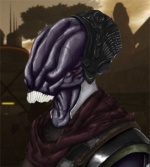 A Draethos tribal leader.
A Draethos tribal leader. The Draethos tribes are by far the most dominant population on Nfolgai, occupying the more temperate southern regions of the planet almost exclusively. Evolving on Thosa, a world with conditions much like those on Nfolgai, the Draethos were ideally suited to thrive in their new environment. Their communicative telepathy also gave them a great advantage when competing with the other slave populations, leading to their decimation of the human population through warfare and control over resources. This telepathy also left them far more vulnerable to the Dark Side energy that the planet was steeped in, especially in the southern regions near the Temple of Sorzus Syn. The tribal units of the Draethos are usually under the control of a single male leader, most often the strongest or most cunning warrior of the tribe. Leadership is not hereditary, with the role of tribal leader passing to the next strongest male following the death of the current leader. Other males may also challenge the current tribe leader to single combat in order to usurp his position. This combat is nearly always to the death, though in rare cases, it is enough merely to maim or cripple an opponent.
The warped Draethos societies of the south engage in almost constant tribal warfare, either over resources or inter-tribal disagreements over tradition or relationships. Magnified by the Dark Side, their baser urges have, for the most part, overpowered their more evolved thinking. Tribal life is harsh and unforgiving, with murder being the most common cause of death. Disagreements over pair bonding or resources often lead to combat and casualty, with the victor then being hunted down and killed by the loser's family. This leads to yet more death in a nearly endless cycle of retribution and revenge killings. This makes inter-tribal gatherings nearly impossible, as individuals will invariably encounter a member of another rival tribe who has killed some member of their family or tribe. These encounters often end with death for one of the participants, eventually leading to another tribal war.
Draethos villages mostly subsist on food produced through settled agriculture, but they do not raise any domesticated animals. Instead, their cultural predisposition towards hunting means that they gain most of their protein sources through hunting either wild animals or Mrlssi groups that venture too far south. Many tribes do also consume their fellow Draethos, eating their own dead or those of tribes they defeat in war.
Mrlssi
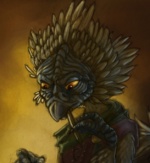 A Mrlssi tribesman.
A Mrlssi tribesman.In contrast to the Draethos populations of Nfolgai, the Mrlssi tribes are far less violent or openly hostile. This should not, however, be confused with the idea that they are not hostile towards outsiders or one another. While there is little of the fighting engaged in by the Draethos over tribal slights, the Mrlssi still clash over the scarce resources of their habitat range. They do not suffer from the same need to engage in retribution killing that the Draethos do against one another, so these clashes are usually quick and do not cause an escalating cycle of violence.
The Mrlssi tribes are, on the whole, smaller than their Draethos counterparts, with social groups rarely exceeding forty to fifty members. Within these tribal groups, leadership is invested in a group of knowledgeable individuals, with most tribes being led by three to five Mrlssi. Given the scarcity of resources, the Mrlssi expend very little caring for the infirm or the injured. This harsh reality is dictated by the circumstances of their surroundings, but it is also likely influenced by the Dark Side energy of the world that they inhabit. Similar to the Draethos, the Mrlssi are driven by their darker base instincts instead of higher morality, though to a lesser extent than the Draethos.
With their habitat reduced to the extreme northern latitudes of Nfolgai, the Mrlssi are unable to engage in any settled agriculture. Instead, they live a hunter-gatherer lifestyle, subsisting on whatever resources they can find in their territory. This means that most Mrlssi tribes are nomadic with larger ranges than the Draethos, moving throughout their territory at different times of the year in order to follow the resources they need to live. With little in the way of animal life to hunt, the Mrlssi get most of their protein intake from the large insects native to much of their territory.
In the area around the Temple of Sorzus Syn, there are small groups of Mrlssi intermingled with the Draethos. It is thought that the slave descendants in this area have been so warped by exposure to Dark Side forces that they have lost all semblance of their own identities. Draethos and Mrlssi, subsequently, have been reduced to mere wild, Force-crazed creatures.
Locations
Temple of Sorzus Syn
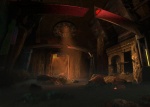 The temple entryway.
The temple entryway.The great burial temple of Sorzus Syn is located deep in the jungles of the southern hemisphere of Nfolgai. The temple, which is believed to hold the body of Sorzus Syn, is hidden from many who do not already know its position, and ithas remained a mystery to the Sith and their Lore for many millennia. No one is entirely sure if Syn is indeed buried in the temple, or if it was simply used for ancient Sith rituals.
The entrance to the temple is located under the thick jungle canopy of Nfolgai, making any aerial approach impossible. The majority of the temple is located within a carved out mountainside with the entrance marked by symbols above the main archway symbolizing Sorzus Syn. The entirety of the mountainside complex also contains several other tombs, focusing chambers, and libraries dedicated to studying the lives of the many Sith Lords buried there. A recurring theme that is immediately noticeable at the entrance of the facility is the broken pillars overhead, which are in the shape of a triangle, one which Syn personally preferred as noted by the symbol throughout the temple. The main structure of the temple is also in the shape of a pyramid.
The temple itself is thoroughly booby trapped and contains ancient wards to help protect the integrity of the structure from unwanted outside invaders. The jungle surrounding the temple is protected by the descendants of the salve Mrlssi and Draethos, armed with only simple weapons and a rudimentary ability to control the Force. They are not often found inside the complex itself, but they are more than willing to intrude on the work of their ancestors in order to eliminate any outside forces. The little wildlife that is on the planet avoids the temple at all costs, most likely due to its extremely strong connection to the Dark Side of the Force.
Render Crash Site
 The still exposed command tower of the Render.
The still exposed command tower of the Render.Located in the northern ice wastes of Nfolgai, the Interdictor-class cruiser Render was discovered by the One Sith, buried deep in the ice and snow in the year 35 ABY. Originally the cause of the crash of the Render was not evident from the wreckage, somewhat of a mystery given the fact that the overall structure of the vessel was still well preserved. The outside hull of the ship has begun to succumb to the biting frost of the northern tundra, exposing the immediate internal sections of the ship to the weather. The seemingly powerless ship is just as cold and dead as the outside of it. Frost and ice has penetrated the depths of the vessel, causing immense frost to build it in many of the internal compartments. This caused the metal to begin the slow process of erosion, which would continue on for many more millennia.
However, as cold and desolate as the Render appears to be, it is a refuge for some of the corrupted Mrlssi who find themselves calling the ship home. Perhaps maddened by the Force, or preferring the internals of the ancient warship rather than the unforgiving destruction of the Nfolgai tundra, the Mrlssi have spread themselves throughout many compartments of the ship while also leaving much of it unexplored even by their own people over the years.
The more recent One Sith expeditions have begun their explorations of the ship, trying to avoid the Mrlssi inhabited sections while searching for relics that may hold knowledge, power, or designs for ancient weapons and defenses to help bolster their forces.
Behind the Scenes
While Nfolgai is a planet that does exist within the Star Wars canon, the dearth of information on it provided many opportunities to create original content. The included history incorporates many non-specified elements of the Star Wars universe, specifically the journeys of Sorzus Syn and the settlement of the original Sith Empire under Adas, into Nfolgai's backstory. In addition, it takes other elements from RPG resources that are dictated by player action and works them into the history. One example of this would be Darth Voren helping the Jedi Strike team capture Revan, one possible outcome in The Betrayal of Darth Revan adventure supplement.
Additionally, real world events and information were also incorporated into the article. The Republic and Sith battle over Nfolgai during the Great Galactic War was inspired by the United States Navy and Marine's defense of Wake Island against the Japanese in the opening days of World War II, with the surprise attack on Korriban taking the place of Pearl Harbor. The information on the Draethos and Mrlssi tribes, such as the frequency of retribution based murders and the use of large insects as a primary source of protein, was based on descriptions of the tribes of New Guinea from Jared Diamond's book Guns, Germs, and Steel: The Fates of Human Societies.
Contributors